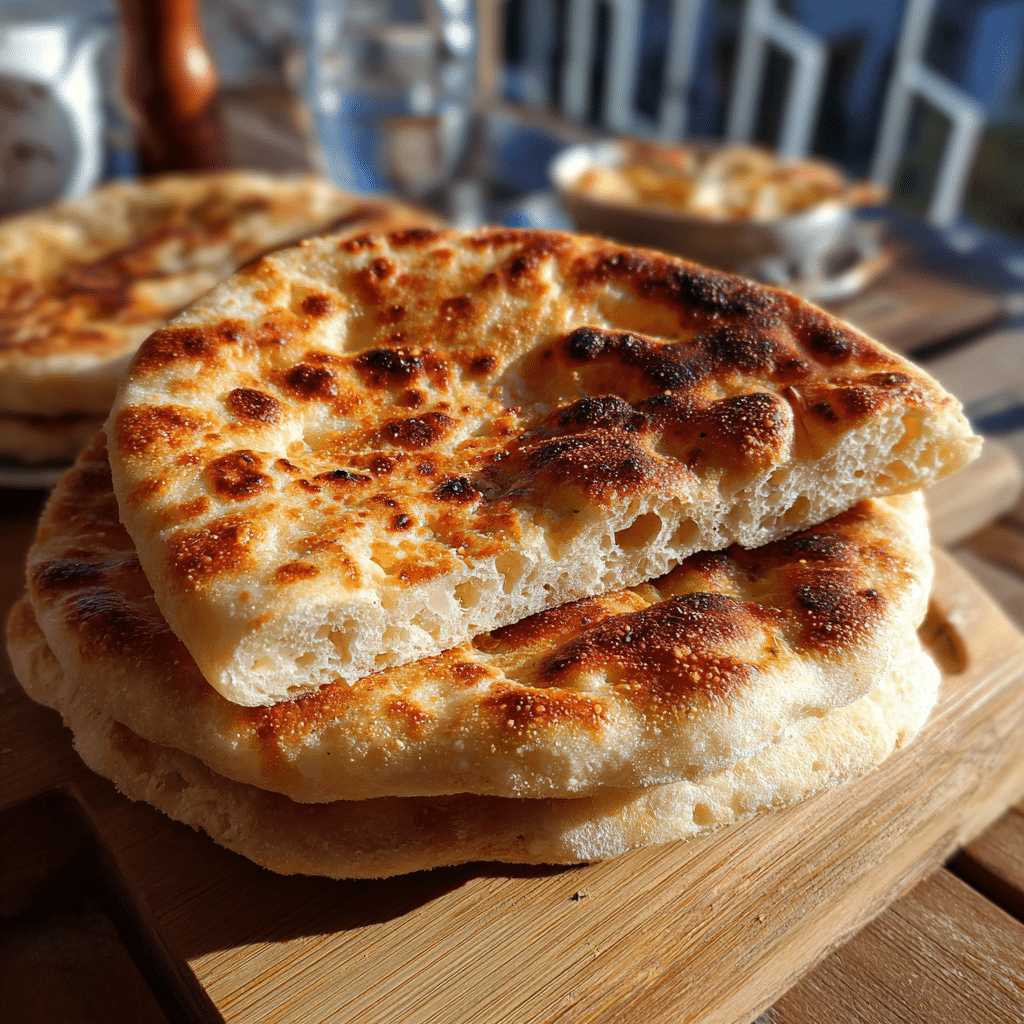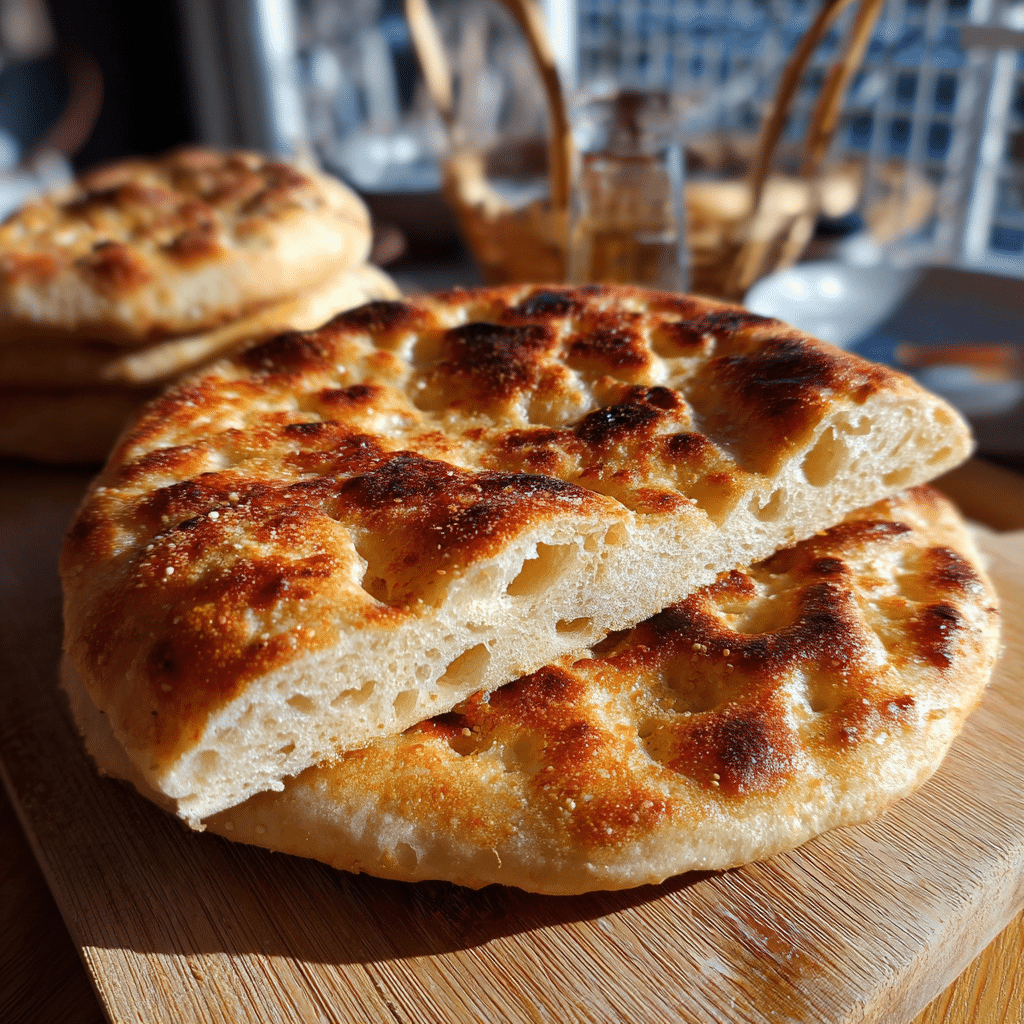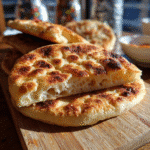Turkish Bread Recipe (Bazlama) transformed my perspective on homemade bread forever. I’m Michael, a passionate culinary artist at FoodyDish.com, and I still remember the first time I tasted authentic bazlama during a culinary expedition through Istanbul. The soft, pillowy texture and slightly charred spots created a flavor profile that stayed with me long after returning home. Like many home cooks, I was intimidated by bread-making the long rising times, precise temperatures, and fear of dense, disappointing results. But bazlama changed everything.
This Turkish bread recipe delivers restaurant-quality flatbread with minimal effort and maximum flavor. Unlike crusty European breads that require specialized equipment, bazlama comes together with pantry staples and cooks perfectly in a simple skillet. Whether you’re tired of store-bought pita that tastes like cardboard or you’re seeking an authentic vessel for kebabs and dips, this recipe promises golden, tender bread that puffs beautifully on your stovetop.
As someone who’s spent years reimagining traditional dishes and creating bold new flavors, I’ve tested this recipe countless times to ensure it works flawlessly for beginners and experienced bakers alike. My culinary philosophy centers on making exceptional food accessible to everyone, regardless of dietary needs or skill level. In this guide, you’ll discover meat selection tips for perfect pairings, cooking hacks to prevent common mistakes, storage solutions, and answers to your most pressing questions about Turkish bread.
Why This Turkish Bread Recipe Works
This bazlama recipe succeeds where other flatbread recipes fall short because it balances simplicity with authentic technique. Here’s why home cooks across the FoodyDish.com community have embraced it:
- Uses affordable, easy-to-find ingredients: No specialty flours or hard-to-source items just all-purpose flour, instant yeast, and basic pantry staples you likely already own.
- Quick preparation in under 2 hours: Unlike artisan breads requiring overnight fermentation, bazlama rises in just one hour, making it perfect for spontaneous dinner plans or last-minute gatherings.
- Perfect for weeknights or weekend feasts: The dough is forgiving enough for busy Tuesday evenings yet impressive enough to serve alongside elaborate weekend spreads of grilled meats and Mediterranean mezze.
- Versatile base for countless meals: Use it as sandwich bread, pizza base, or the traditional accompaniment to Turkish kebabs, hummus, and baba ganoush.
Choosing the Right Meat for Your Turkish Bread Recipe
Best Cuts to Pair with Bazlama
Turkish bread shines when paired with properly selected meats that complement its tender, slightly chewy texture. Lamb shoulder works beautifully for traditional döner-style preparations, offering rich marbling that keeps the meat succulent during grilling. Chicken thighs provide juiciness that boneless breasts simply cannot match the higher fat content prevents drying and creates flavorful drippings perfect for soaking into warm bazlama.
For beef lovers, ribeye or sirloin strips deliver the marbling necessary for quick, high-heat cooking methods favored in Turkish cuisine. The intramuscular fat melts during cooking, creating those irresistible charred edges that contrast beautifully with pillowy bread.
Buying Tips for Quality Protein
When shopping for meats to accompany your Turkish bread recipe, look for bright red color in beef cuts without excessive browning or gray patches. Fresh lamb should have a pale pink hue with firm, white fat. Ask your butcher for thin-sliced cuts specifically for kebabs they’ll often slice against the grain for you, ensuring maximum tenderness.
For chicken, choose skin-on thighs when possible. The skin crisps beautifully and adds another textural dimension to your meal, though it can be removed before serving if preferred.
Protein Substitutions
Don’t have lamb? Swap pork shoulder for equally tender results in slow-cooked preparations. Ground beef or turkey works wonderfully for kofta-style preparations wrapped in warm bazlama. Vegetarians can substitute portobello mushrooms or halloumi cheese both develop gorgeous char marks and pair exceptionally with the bread’s subtle sweetness.
Ingredients & Prep for Turkish Bread Recipe
Bread Preparation Essentials
The key to perfect bazlama lies in proper dough handling. Unlike European breads requiring aggressive kneading, Turkish bread develops gluten through gentler, rhythmic folding. This creates the characteristic soft interior while maintaining enough structure for the dramatic puffing that occurs during cooking.
Temperature matters significantly warm water and milk (around 110°F) activate yeast without killing it. Too hot, and you’ll destroy the yeast culture; too cool, and rising times extend dramatically.
Creating the Perfect Dough
Begin by combining 1 cup warm water, ½ cup warm milk, 1 teaspoon sugar, and 1 packet instant yeast. This sugar feeds the yeast, creating that essential foamy layer within 5–10 minutes. If your mixture doesn’t foam, your yeast may be expired or your liquids too hot start over for guaranteed success.
Add 3½ cups all-purpose flour, 1½ teaspoons salt, and 2 tablespoons olive oil. The olive oil enriches the dough, creating tender crumb and preventing excessive dryness. Knead for 8–10 minutes until the dough becomes smooth and elastic it should spring back when poked gently.
Pantry Staples for Turkish Bread Success
Beyond the core ingredients, keep these items handy: extra flour for dusting surfaces, olive oil or melted butter for brushing finished breads, and optional toppings like nigella seeds, sesame seeds, or za’atar for flavor variations. These simple additions transform basic bazlama into restaurant-worthy presentation.

Step-by-Step Cooking Instructions for Turkish Bread Recipe
Pre-Cooking Prep for Turkish Bread Recipe
After the first rise (when dough doubles in size after about 1 hour in a warm spot), punch it down to release accumulated gases. Divide the dough into 6–8 equal pieces I use a kitchen scale for precision, aiming for approximately 90–100 grams each. Roll each portion into a smooth ball, then cover with a damp towel for 10 minutes. This resting period relaxes the gluten, making rolling significantly easier.
Cooking Method for Turkish Bread Recipe
Heat a large nonstick skillet or well-seasoned cast-iron pan over medium heat no oil needed. Roll each dough ball into a ½-inch thick round (about 6–7 inches diameter). Don’t worry about perfect circles; rustic shapes add authenticity.
Place one round in the hot, dry pan. Within 60–90 seconds, you’ll notice bubbles forming on the surface this is exactly what you want. When the bottom develops golden-brown spots (check by lifting an edge), flip carefully. Cook the second side for 2–3 minutes until similarly spotted and the bread puffs dramatically.
Doneness Check for Turkish Bread Recipe
Unlike meat requiring thermometers, bazlama signals doneness visually. Look for those characteristic brown spots (called “leopard spotting” in bread-making circles) and noticeable puffing. The bread should sound slightly hollow when tapped and feel soft yet structured.
Resting Your Turkish Bread Recipe
Transfer cooked breads to a plate and immediately brush with melted butter or olive oil. Stack them and cover with a clean kitchen towel the residual steam keeps them incredibly soft. Unlike crusty breads that benefit from cooling uncovered, bazlama stays wrapped to maintain its pillowy texture.
Pro Tips for Perfect Turkish Bread Recipe
Avoiding Dense or Tough Bread
Don’t overcrowd your pan with dough or cook over excessively high heat. Medium heat allows the interior to cook through while developing those beautiful surface spots. If your bread cooks too quickly on the outside while remaining doughy inside, reduce heat slightly.
Never skip the resting period after dividing dough those 10 minutes make rolling effortless and prevent shrinkage during cooking.
Tool Recommendations for Turkish Bread Recipe Success
Invest in a reliable kitchen thermometer for testing water temperature it eliminates guesswork. A cast-iron skillet distributes heat more evenly than thin pans, though nonstick works perfectly fine. A rolling pin creates uniform thickness, though a wine bottle works in a pinch.
Storage & Reheating Your Turkish Bread Recipe
Store cooled bazlama in airtight bags at room temperature for 2 days, refrigerated for 5 days, or frozen for up to 3 months. Reheat in a dry skillet over medium heat for 30 seconds per side, or wrap in damp paper towels and microwave for 15–20 seconds. The bread regains its soft texture beautifully, tasting nearly as good as fresh.
Flavor Variations for Turkish Bread Recipe
Spicy Twist
Incorporate ½ teaspoon red pepper flakes or Aleppo pepper into your dough for subtle heat that complements grilled meats beautifully. Brush finished breads with chili-infused olive oil for an extra kick.
Herb-Infused Options
Add 2 tablespoons finely chopped fresh parsley, dill, or mint directly into the dough. These herbs create aromatic breads perfect for breakfast spreads or cheese platters.
Gluten-Free Adaptation
While traditional bazlama requires gluten for proper texture, you can substitute with a 1:1 gluten-free flour blend plus 1 teaspoon xanthan gum. Results won’t be identical but remain delicious and functional.
| Variation | Key Ingredient | Best Pairing | Dietary Note |
|---|---|---|---|
| Traditional | All-purpose flour | Lamb kebabs | Standard |
| Whole Wheat | 50% whole wheat flour | Vegetable spreads | Higher fiber |
| Garlic-Herb | 3 cloves minced garlic, 2 tbsp herbs | Grilled chicken | Vegan-friendly |
| Spicy | ½ tsp Aleppo pepper | Beef kofta | Vegan-friendly |
| Gluten-Free | GF flour blend + xanthan gum | Any protein | Celiac-safe |
Serving Suggestions for Turkish Bread Recipe
Serve your warm bazlama alongside classic Turkish accompaniments: creamy hummus, smoky baba ganoush, tangy cacik (yogurt-cucumber dip), and spicy ezme salad. For heartier meals, wrap grilled lamb köfte, chicken şiş, or vegetarian falafel inside.
Pair beef dishes with full-bodied Cabernet Sauvignon or Turkish Öküzgözü wine. Lamb benefits from Syrah or earthy Tempranillo. For beer lovers, a crisp pilsner or wheat beer like Hefeweizen complements the bread’s subtle sweetness without overwhelming delicate flavors.
FAQs About Turkish Bread Recipe
Can I use frozen meat with bazlama? Absolutely. Thaw meat completely in the refrigerator overnight, then pat dry before seasoning. Frozen meat won’t develop proper char marks and releases excess moisture that can make your bread soggy.
How do I fix overcooked bread? If your bazlama becomes too dry, brush generously with olive oil or melted butter and wrap tightly in foil. Warm in a 300°F oven for 5–7 minutes to rehydrate slightly.
Is this recipe safe for pregnant women? Yes, when paired with fully cooked meats. Ensure all proteins reach safe internal temperatures (165°F for poultry, 145°F for whole cuts of beef/lamb) to eliminate foodborne illness risks.
Can I make the dough ahead? Definitely. Prepare dough through the first rise, then refrigerate for up to 24 hours. Bring to room temperature before shaping and cooking for best results.

Conclusion
Fire up your skillet and experience the magic of homemade Turkish bread recipe tonight! This bazlama delivers bakery-quality results with minimal equipment and maximum flavor. Join over 5,000 home cooks in the FoodyDish.com community who’ve transformed their meals with this versatile, delicious flatbread.
Ready for more culinary adventures? Try our Homemade Pita Bread Guide or explore Traditional Turkish Meze Recipes to create an authentic feast. Through captivating recipes and meaningful narratives, we’re building a community that celebrates creativity in the kitchen and turns everyday meals into extraordinary experiences. Share your bazlama creations with #FoodyDishBazlama I can’t wait to see your beautiful breads!
you loved this recipe, don’t forget to share it with your friends or save it to try later!
I’d be thrilled to see your personal touch share your photos on If Pinterest
Print
Turkish Bread Recipe (Bazlama): Soft, Pillowy Flatbread in Minutes
- Total Time: 1 hr 35 mins
- Yield: 6–8 flatbreads 1x
Description
This homemade Turkish Bread is soft, fluffy, and slightly chewy with golden brown spots. Perfect with dips, soups, or grilled meats.
Ingredients
4 cups (500 g) all-purpose flour
1 ½ teaspoons salt
1 tablespoon sugar
2 ¼ teaspoons (1 packet) instant yeast
1 ½ cups (360 ml) warm water
3 tablespoons olive oil (plus extra for brushing)
Optional: sesame seeds or nigella seeds for topping
Instructions
1. In a large mixing bowl, combine flour, salt, and sugar.
2. Add yeast, warm water, and olive oil. Mix until a soft dough forms.
3. Knead for 8–10 minutes until smooth and elastic.
4. Place dough in a greased bowl, cover, and let rise for 1 hour or until doubled in size.
5. Punch down the dough and divide into 6–8 equal balls.
6. Roll each ball into a round flatbread about ¼ inch thick.
7. Heat a skillet or griddle over medium-high heat. Cook each bread for 2–3 minutes per side until puffed and golden brown spots appear.
8. Brush with olive oil and sprinkle with seeds if desired. Serve warm.
Notes
If dough is sticky, add 1–2 tablespoons of flour during kneading.
For softer bread, cover cooked bread with a clean towel until serving.
Can be frozen once cooled — reheat in a dry skillet or oven.
- Prep Time: 15 mins
- Cook Time: 20 mins
- Category: Bread, Side Dish
- Method: Stovetop, Skillet
- Cuisine: Turkish, Middle Eastern
Nutrition
- Serving Size: 1 bread
- Calories: 200
- Sugar: 2g
- Sodium: 240mg
- Fat: 5g
- Saturated Fat: 0.7g
- Unsaturated Fat: 4g
- Trans Fat: 0g
- Carbohydrates: 34g
- Fiber: 2g
- Protein: 6g
- Cholesterol: 0mg
Keywords: Turkish Bread, Bazlama, Pide Ekmeği, Flatbread Recipe

